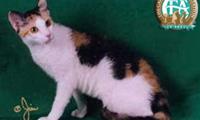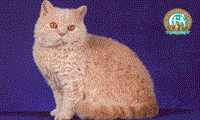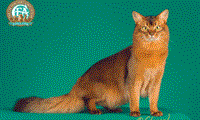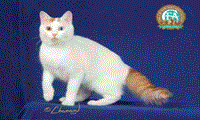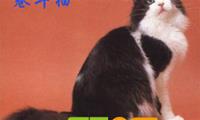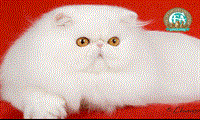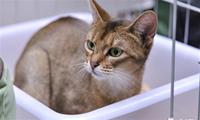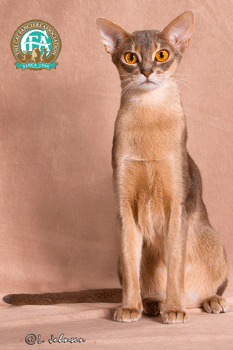
阿比西尼亞貓又稱衣索比亞貓、芭蕾舞貓。 因為阿比西尼亞貓的毛色同野兔相保, 英國人亦稱它為“免貓”。
阿比西尼亞貓歷史悠久, 原產于阿比西尼亞(今衣索比亞)。 在保存下來的古埃及神貓的木乃伊中, 有一種血紅色的貓與它十分相像, 因此, 許多人認為它是古埃及神貓的直系後代。 由於它的整體外形、毛色、直立耳均同非洲山貓接近, 亦有人認為它源於非洲山貓。
體形:阿比西尼亞貓身軀柔軟靈活, 其外表與暹邏貓有些許類似, 但是整個體態要比暹邏貓來得豐腴一些, 阿比西尼亞貓有著楔形的臉蛋、大而尖的耳朵、呈杏仁狀的雙眼,
毛色:阿比西尼亞貓目前公認的毛色為兩種, 即紅褐色種和紅色種。 紅褐色種全身色調為紅褐色。 毛尖呈黑色或黑褐色, 近毛根部為紅黃褐色。 完全深色毛尖時, 背部允許深色。 下毛紅黃褐色(紅色、黃褐色交叉)層尖的毛尖黑色。 前胸部、腹部和前肢內側被毛顏色與整體顏色協調一致,以黃褐色最為理想。 下齶部淡黃色。 鼻鏡呈磚紅色。 足趾間黑色或茶色,足趾至爪尖都為黑色。
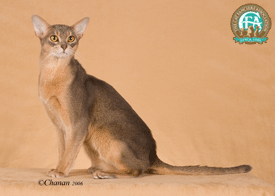
頭部:頭形精巧, 為稍帶圓的三角形。
耳:耳大而直立, 基部寬, 耳廓邊緣很薄, 耳端稍尖並前傾。 耳毛短而密, 紅褐色種毛尖黑色或黑褐色;紅色種毛尖呈巧克力色。 耳內長有飾毛。
眼睛:眼大呈杏仁形,略吊眼梢;眼緣黑色,周圍為褐色毛覆蓋。 眼色為綠、黃、淡褐等色。
四肢:四肢細長, 腳爪纖巧, 與圓形而修長的身材協調一致。
趾:趾為小而堅實的卵形。 立起時, 能看到用爪尖站起來。
尾:尾長而尖, 呈錐形, 尾根部粗大。
頭部 25分 嘴 6分頭顱 6分 耳朵 7分眼形 6分 身體 30分身軀 15分 腿及腳 10分尾巴 5分 毛髮、毛質 10分顏色 35分 毛色 15分毛髮條紋 15分 眼色 5分
CFA官方網站關於阿比西尼亞貓的品種介紹:
Breed Profile: Abyssinian
Although the Abyssinian is one of the oldest known breeds, there continues to be speculation and controversy concerning its history. In appearance, Abyssinians resemble the paintings and sculptures of ancient Egyptian cats which portray an elegant feline with a muscular body, beautiful arched neck, large ears and almond shaped eyes. Abys today still retain the jungle look of felis lybica, the African wildcat ancestor of all domestic cats.
The source of the name is not because Ethiopia, formerly Abyssinia, is thought to be the original home of these cats, but because the first "Abyssinians" exhibited in shows in England were reported to have been imported from that country. The first mention is in the Harper's Weekly (January 27, 1872 issue) where the 3rd prize in the December, 1871 Crystal Palace show was taken by the Abyssinian Cat ("captured in the late Abyssinian War"). This article is accompanied by an illustration of the Abyssinian Cat. In the British book, by Gordon Stables, Cats, Their Points, and Characteristics... published in 1874, there is also mention of an Abyssinian. The book shows a colored lithograph of a cat with a ticked coat and absence of tabby markings on the paws, face and neck. The description reads: "Zula, the property of Mrs. Captain Barrett-Lennard. This cat was brought from Abyssinia at the conclusion of the war..." British troops left Abyssinia in May 1868, so that may have been the time when cats with ticked coats first entered England. Unfortunately, there are no written records tracing the early Abyssinians to those imported cats, and many British breeders are of the opinion that the breed was actually created through the crossing of the various existing silver and brown tabbies with native British "Bunny" ticked cats.
Recent studies by geneticists show that the most convincing origin of the Abyssinian breed is the coast of the Indian Ocean and parts of Southeast Asia. In fact, the earliest identifiable Aby is a taxidermal exhibit still residing in the Leiden Zoological Museum in Holland. This ruddy ticked cat was purchased around 1834-1836 from a supplier of small wild cat exhibits and labeled by the museum founder as "Patrie, domestica India." Although the Abyssinian as a breed was refined in England, its introduction to that country and others may have been the result of colonists and merchants stopping in Calcutta, the major port for the Indian Ocean.
The first Abyssinians to be imported to North America from England arrived in the early 1900s, but it was not until the late 1930s that several top quality Abys were exported from Britain to form the foundation of today's American breeding programs.
As described in the Abyssinian Breeders International "Kitten Buyer's Guide" by Carolyn Osier, "Abyssinians must be one of the most intelligent animals ever created." This handbook for the potential Aby owner describes these cats as "...a very people-oriented cat. Not a lap cat... but a cat that likes to be with people, a cat that wants to know what you are doing - that wants to help. There is probably no breed anywhere more loyal than the Aby. Once you have acquired an Aby as a companion, you will never be able to complain that no one understands you. Abys are very good at training people to do just what they want them to do."
Pricing on Abyssinians usually depends on type, applicable markings and bloodlines distinguished by Grand Champion (GC), National, National Breed and/or Regional winning parentage (NW, BW, RW) or of Distinguished Merit parentage (DM). The DM title is achieved by the dam (mother) having produced five CFA grand champion/premier (alter) or DM offspring, or sire (father) having produced fifteen CFA grand champion/premier or DM offspring. Usually breeders make kittens available between twelve and sixteen weeks of age. After twelve weeks, kittens have had their basic inoculations and developed the physical and social stability needed for a new environment, showing, or being transported by air. Keeping such a rare treasure indoors, neutering or spaying and providing acceptable surfaces (e.g. scratching posts) for the natural behavior of scratching (CFA disapproves of declawing or tendonectomy surgery) are essential elements for maintaining a healthy, long and joyful life.
There are CFA clubs devoted to the promotion, protection and preservation of the Abyssinian breed. For more information, please send inquiries to CFA, PO Box 1005, Manasquan NJ 08736-0805.
